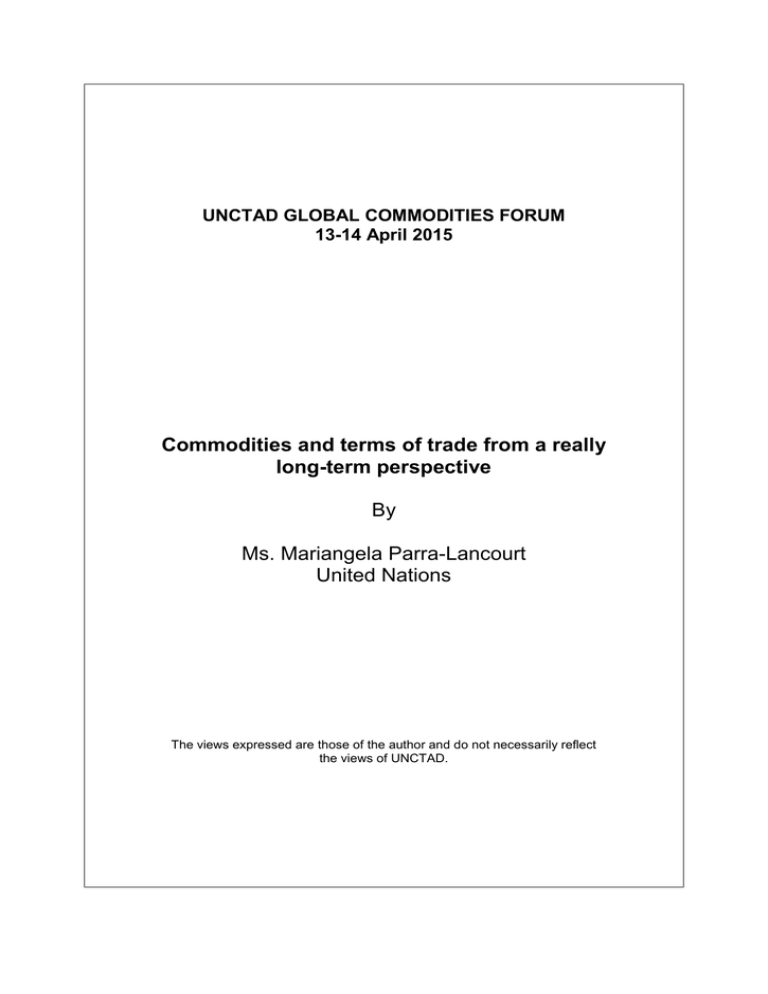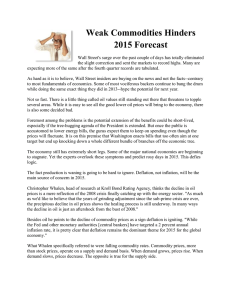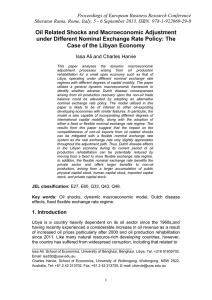Commodities and terms of trade from a really long-term perspective By
advertisement

UNCTAD GLOBAL COMMODITIES FORUM 13-14 April 2015 Commodities and terms of trade from a really long-term perspective By Ms. Mariangela Parra-Lancourt United Nations The views expressed are those of the author and do not necessarily reflect the views of UNCTAD. GLOBAL COMMODITIES FORUM COMMODITIES AND TERMS OF TRADE FROM A REALLY LONG-TERM PERSPECTIVE MARIANGELA PARRA-LANCOURT UNITED NATIONS Geneva, April 14, 2015 REAL OIL PRICES INCREASED THREEFOLD SINCE 1999 NON-OIL COMMODITY PRICES JUST RECOVERED, DOUBLING METALS LED THE GROUP PUTTING IT IN PERSPECTIVE METALS REMAINED DEPRESSED AFTER 1921 TROPICAL COMMODITIES ARE THE MOST AFFECTED IN BUSTS STEPWISE DECLINE IN NON-OIL COMMODITY PRICES Ocampo-Parra 2010 VOLATILITY AND CUMULATIVE DECLINE Cashin and McDermott (2002) found a downward trend of 1.3% per year. Oddly enough, they interpreted it as small compared to the variability of prices, even though it translates into a cumulative decline of 75%!!! over 18621999 The far-reaching changes that the world economy underwent around 1920 and again around 1979 led to a stepwise deterioration reflected in roughly a halving of real commodity prices OCAMPO-PARRA 2010: EVIDENCE The largest price drops followed, with a lag, the two major slowdowns in the industrialized economies’ long-term growth rates during the First World War and in 1973, respectively This reflects the crucial role that world economic growth has as a determinant of the commodity terms of trade. Will the Great Recession and recent deceleration of emerging markets be followed by large drops? Too early to know, but if history is any indication it may well be the case ERTEN-OCAMPO (2012): OVERLAPPING SUPER CYCLES Super Cycle Components for Non-oil Subindices 0.4 Super Cycle Components for Non-oil and Oil Prices 0.8 0.3 0.6 0.2 0.4 0.1 0.2 0.0 0.0 -0.1 -0.2 -0.2 -0.3 -0.4 -0.4 -0.6 -0.5 1875 1900 1925 1950 1975 2000 -0.8 1875 Non-tropical super cycle Metals super cycle 1900 1925 1950 1975 2000 Tropical super cycle Non-oil total super cycle Oil super cycle WORLD ECONOMIC ACTIVITY IS A STRONG PREDICTOR OF COMMODITY PRICES Super Cycle Components, Global Output and Total Non-oil Commodity Prices (Log scaling) .2 Super Cycle Components, Global Output and Metal Prices (Log scaling) .3 .2 .1 0.100 .1 0.075 .0 0.050 -.1 0.025 -.2 0.000 -.3 -0.025 -.4 -0.050 -0.050 -.5 -0.075 -0.075 0.100 .0 0.075 0.050 -.1 0.025 -.2 0.000 -0.025 -.3 -0.100 -0.100 1875 1900 1925 1950 1975 OECD GDP (left axis) World GDP (left axis) Total Non-oil Commodity Prices (right axis) 2000 1875 1900 1925 1950 1975 OECD GDP (left axis) World GDP (left axis) Metal Prices (right axis) 2000 CONCLUSIONS: ERTEN-OCAMPO (2012) • A major characteristic of commodity prices is 30-40 year-long super cycles, overlapping significantly across sub-indices (including oil since the 1950s). • The amplitudes vary between 20-40 percent from long-run trend: tropical agriculture exhibits supercycles with greater amplitude. • The mean of each super-cycle for non-fuel commodities has a tendency to be lower than previous one, a step-wise deterioration over time. CONCLUSIONS: ERTEN-OCAMPO (2012) • Commodity price boom could have lasted only if China and other major developing countries were capable of delinking from slow growth in developed countries. • Commodity-dependent countries should be aware of price cycles • Develop policies to take advantage of the expansionary phases • While taking precautionary action against the contraction phases • Step-wise deterioration underlines the importance of diversification. Diversify towards what? OCAMPO-PARRA (2006) TWO TRADITIONAL EXPORT STRATEGIES AND FALLACY OF COMPOSITION 1. 2. Increasing market shares in sectors where a specific country has an established position Diversifying into higher technology products The actual strategy of an individual country may involve a mix between them Individual countries can succeed in any of these strategies As a group, developing countries can only succeed in the first if developed countries lose market shares Without protectionism and if the demand is elastic enough THE TWO VARIANTS OF THE PREBISCH-SINGER HYPOTHESIS 1. Different income-elasticities of demand for commodities vs. manufactures, due to changes in the structure of production/demand: applies only to goods and services that exhibit a low income-elasticity of demand / what matters is the goods and services being traded 2. Asymmetries in the structure of labor markets generate unequal distribution of the benefits of technical progress: applies to all goods and services produced by developing countries / what matters is where they are produced GLOBAL VALUE CHAINS HAVE BEEN INSTRUMENTAL IN COMMODITIZATION OF MANUFACTURES WITH US CPI THE CUMULATIVE FALL HAS BEEN EVEN MORE PRONOUNCED A THIRD STRATEGY? • Trade in tasks offer opportunities to developing countries • Trade facilitation is needed but active policies are crucial • Building production capabilities that can be used in similar products • Accompanied by incentives and regulations to avoid footloose and exploitative interactions • Avoid race to the bottom in taxes and regulation • Control trade misinvoicing: Commercial illicit financial flows (including tax evasion, trade and services mis-pricing and transfer pricing by multinational corporations) account for the largest proportion of illicit financial flows in Africa SUMMARY 1. The recent boom was much more pronounced for oil and metals. 2. Analysis of the Prebisch-Singer hypothesis follow the evolution of time-series econometrics 3. Commodity prices decreased in a stepwise fashion in the twentieth century 4. Tropical commodities (banana, cocoa, coffee, jute, palmoil, rice, rubber, sugar, tea) 5. Volatility is high, but should not let us forget the decrease in commodity price levels SUMMARY 6. Super cycles analysis confirms stepwise deterioration 7. World economic activity is a strong predictor of commodity prices 8. Diversification is advised but diversify towards what? Increasing market shares in established positions Diversifying into higher technology products Global value chains? GLOBAL COMMODITIES FORUM COMMODITIES AND TERMS OF TRADE FROM A REALLY LONG-TERM PERSPECTIVE MARIANGELA PARRA-LANCOURT UNITED NATIONS parra@un.org 1(212)9634690 Geneva, April 14, 2015








